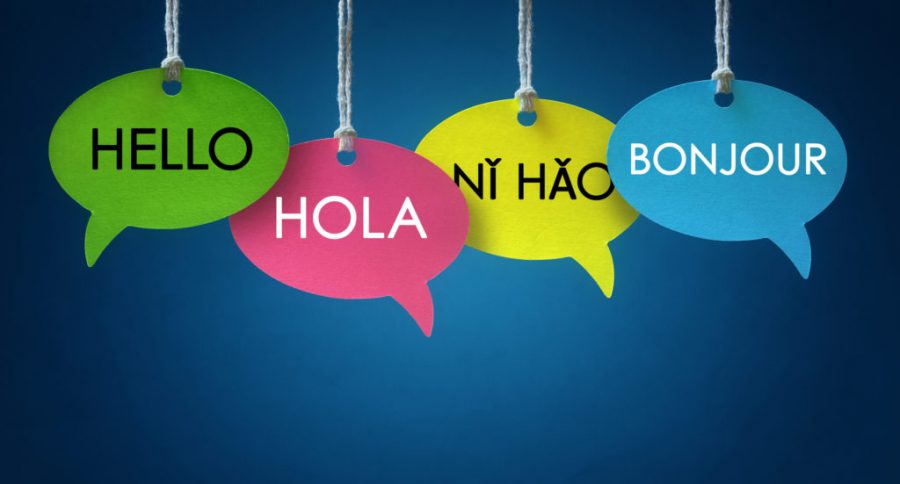Broadening the Perspective on Languages in the High School
February 10, 2021
The United States has no official language. The New World has always boasted a plethora of languages. Indeed, even in the streets of Philadelphia surrounding the 1787 Constitutional Convention, where English-speaking politicians ratified the United States’ most important document, German-speaking farmers rolled carts and wagons full of vegetables, live fowl, and pork to sell to the Philadelphia urbanites. Speakers of Pennsylvania Dutch probably had stunted conversations with these German salespeople as they bought fresh food in this colonial market.
Language as an aspect of America’s national identity is becoming more and more relevant; the presence of non-English languages in America is growing. According to 2017 Census data, 40 million Americans speak Spanish at home, a 133.4% increase since 1990. 63 million Americans in total speak another language at home, and more than 25 million struggle with English. In Westchester county, over a third of residents speak a language other than English at home. Just thirteen miles north of Hastings-on-Hudson, in the Bronx, that figure rises to almost 60%.
Even though only about 13.6% of Hastings residents speak a language other than English at home, this development still provides exciting new opportunities. As poet Johann Wolfgang von Goethe wrote in the 19th century, “He who does not know foreign languages knows nothing of his own.”
Ms. Sciales, a Spanish teacher, underscored the importance of language diversity: “Teaching a foreign language is really important. You give students a chance to expand their worldview and introduce them to a new culture. It improves students’ literacy skills and, in the case of Latin-derived languages, helps them with standardized tests.” Indeed, in a study involving 37 districts, dual-language students scored higher on tests compared to English-only students. In a four-year study conducted by American University, students in dual-language programs outperformed their monolingual peers on English reading tests.
As Harvard professor Gigi Luk told NPR, “bilingualism is an experience that shapes our brains for a lifetime.” Experts now associate bilingualism with improved attention, happiness, and brain health. Indeed, according to a Canadian study, bilingualism actually protects some dementia patients against the disease’s adverse effects.
“Learning a language offers a new worldview,” added Mr. Lopez, a Spanish teacher. “It helps students develop empathy and a global perspective.” His assertion conforms with scientific evidence. As reported by NPR, dual-language programs help children of all backgrounds feel comfortable and accepted in their environments.
This empathy is important in an environment where some students are still learning English. According to the Department of Education, 0.6% of Hastings students “speak English less than very well.” Mr. Lopez recalled, “In my first year here, in my level three Spanish class, there was a junior from a Spanish-speaking country. I think she had been here for a year or two. In my experience, when we spoke in English in my class, she retreated. She didn’t have that bond with other students.” But, said Ms. Sciales, a robust language program can foster empathy: “Language education gives people more compassion for those struggling to learn English. Once they realize it’s not so easy to learn a new language, people won’t be so quick to criticize English language learners.”
Mr. Lopez hopes this community will foster bilingualism through academics, particularly at an earlier age: “Even though I think Hastings has embraced English as the de facto official language, I would love to see the elementary school to establish a true bilingual program. Studies show that at that age students soak up the language like a sponge.” According to research presented by the European Union’s Terminology Coordination program, certain neuromuscular mechanisms responsible for language acquisition, including intonation and pronunciation, are only active until age twelve.
Mr. Lopez admired a program initiated by Herricks district in Nassau County. The program mandates that instructors teach elementary school math and science classes in Spanish. Fransesco Fratto, the director of world languages and immersion at the district, told Newsday that his students, “are thriving and performing at the highest level — and not only in English.”
Mr. Lopez hypothesizes that even small periods of instructional time spent in another language, such as Spanish, would enable young Hastings students to receive the formidable benefits of a bilingual education. Ms. Sciales agreed, “We’re not a large enough school to offer many different languages, but we should enhance what we already have. I think a little extra language instruction at the elementary level would help.”
Of course, language instruction is still accessible to teenagers and young adults despite their changing brain chemistry. Studies show that because teenagers have more advanced cognitive functioning than preadolescents, they can actually gain a more complete understanding of different languages as they learn.
As the array of languages in America becomes more diverse, communities can rely on schools to implement language programs that help students to not only cope with the changes but even to thrive and reap benefits from them.


















